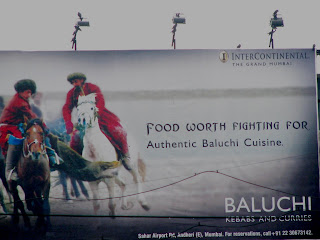-By Parvathy Nair
Yesterday, on my way to drop my son to school, my eyes fell on a hoarding. It showed the popular Afghan sport, Buzkashi. Adjacent to the picture was the line, ‘A cuisine worth fighting for…Baluchi cuisine. Baluch?  as Afghani. Suddenly a series of pictures flashed through my mind. Pictures of mass exodus of refuges, tumultuous events, The Kite Runner, veiled women…And I thought to myself “Do people there really have a lavish cuisine to brag about?” It was more shocking because it was to be spread at Intercontinental, The Grand in Mumbai. Well, that was more than food for thought. I reached home and started looking for information on Afghani cuisine. And I was in for a culinary surprise.
as Afghani. Suddenly a series of pictures flashed through my mind. Pictures of mass exodus of refuges, tumultuous events, The Kite Runner, veiled women…And I thought to myself “Do people there really have a lavish cuisine to brag about?” It was more shocking because it was to be spread at Intercontinental, The Grand in Mumbai. Well, that was more than food for thought. I reached home and started looking for information on Afghani cuisine. And I was in for a culinary surprise.
Afghani food has a great variety because of its multi-ethnicity. And as the country produces high quality fruits like apricots, grapes and pomegranates, they form a major part of Afghani cuisine. Walnuts, plums, berries, pistachios, almonds, pine nuts and
Now comes the most interesting part. An Afghani cuisine does not begin without the destarkhan, the table spread. Irrespective of economic status, the destarkhan is very important to every Afghani family, while welcoming guests. Everybody in the family, including young children are taught to spread a good destarkhan.
The main spices used for seasoning are mint, coriander, saffron, cardamom, cilantro and black pepper, and the preferred meats are either lamb or chicken. Rice dishes are a favourite with Afghanis. Chalow and Palao are rice dishes. That rhymes, isn’t it? Chalow…Palao. While Chalow is plain fluffy rice, Palao is rice cooked in stocks or with meat. Palaos get their names as per the flavours that go into the making of the Palao. Yakhni, Zamarod, Maash, Qorma, Serkah and Shebet are some of the flavoured Palaos. Afghani cuisine also has a good variety of kebabs. The khameerbob or Afghani pasta is also famous for its different versions. And for all those who yearn for some sweetness after a spice filled journey of Palaos, there is Sheer Berinj or rice pudding to soothe your taste buds. There is definitely a lot more to Afghani cuisine than what is mentioned here, as Baluch is just one part and ethnicity of
Hard to believe…right?
There is indeed a colourful picture of
-The author Parvathy lives in Mumbai and blogs at http://paro-kickingboredom.









No comments:
Post a Comment